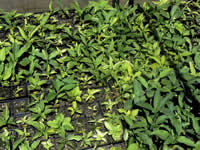
Culling and Selecting Hosta Seedlings
Tips on culling and evaluating Hosta seedlings.
By Joshua Spece
Last revised January 22, 2008
Evaluating and culling seedlings is the most difficult part of hybridizing Hostas. Many people grow fond of the seedlings they so carefully tended. Culling any of them would be akin to choosing a favorite child! From a practical point of view, it is easy to start 1000's of Hostas from seed. Few people have the time or space to grow so many seedlings for any length of time, though. Culling is a necessary evil.
Culling should start early on. Even at the two to three leaf stage you can begin culling. This is when having a well thought out goal comes in very useful. For starters, if you used a streaked pod parent, any non-variegated seedlings can be culled. After all, the whole point of using streaked Hostas is to pass on variegation to the seedlings.
Any seedlings that clearly contradict your goals from the start should be culled. If a cross was intended to produce gold seedlings, cull any that aren't gold. Beyond color, things can get a little tricky. Many characteristics develop with age. Ruffled edges, corrugation, leaf shape, and mature size are difficult, if not impossible, to judge at a young age. Even petiole color can change drastically as a Hosta matures. It goes without saying that any seedling that exhibits a hint of what you are looking for should be kept for further observation.Well thought out goals will help your hybridizing program immensely, but occasionally an unexpected seedling will turn out to be a prized find. A seedling that shows something extremely unique, regardless of your intent, is worth growing on. If a single seedling turns out to be a different color or has a different leaf shape than its siblings, it may turn into something special.
Hybridizers who are working to improve Hosta flowers have an especially difficult task. They can do little culling until the seedlings bloom. These hybridizers usually employ every trick they can to accelerate the growth of their seedlings. Hosta seedlings often don't bloom until their second or third season, but some hybridizers are very successful in getting their seedlings to bloom by the end of the first season.
It probably won't come easy, but the pickier you are the better. The hybridizers developing the most outstanding hybrids keep only a small percentage of their seedlings every year. Perhaps 90% get culled by the end of the first season. Of those remaining, 90% may get culled the following season and so on.
Selecting Hosta Seedlings for Introduction
Only after a Hosta seedling has been grown for four to six years, should you consider naming and introducing it. It takes this long for a Hosta to reach maturity and show what it is really like - good and bad. Though it will cause a slight set back, it is good to divide a promising Hosta seedling so it can be grown in different parts of your garden. Some flaws only become apparent under certain conditions, such as high light or dry soil. Having a back-up of a one-of-a-kind Hosta seedling is always a good idea, too. Unforeseen disasters only strike the most promising plants!
Any seedling can be given a "garden name," but choosing to introduce a Hosta into the trade is a decision that needs careful consideration. New Hosta cultivars are rushed to market all too often without proper evaluation. Many gardeners and collectors have been disappointed one too many times after wasting money on a poor new introduction. Think quality, over quantity. It is a great thrill to introduce the Hosta world to your prized hybrids, but do you really want to be known for introducing inferior plants?
Ask yourself these questions when trying to decide whether a Hosta is worthy of introducing:
- Does the Hosta feature a characteristic never before seen in any other Hosta?
- Does the Hosta combine existing characteristics in a new combination?
- Does the Hosta grow well? Slow growth is not bad, as long as the plant does grow. Vigorous growth is always a positive attribute.
- Does the Hosta perform well in a wide variety of conditions?
- Does the Hosta fit the "Ten Foot" rule? Can the plant be easily identified, without a doubt, from ten feet away?
- Does the Hosta improve an existing characteristic?
- Does the Hosta improve a flaw seen in a similar looking plant?
If you can answer yes to at least one of these questions (the more yeses, the better), your Hosta seedling may be worth introducing. Being able to evaluate these criteria requires that you are familiar with a large number of existing Hosta cultivars. If you are not - and even if you are - getting an opinion from an experienced Hosta grower is a great way to get an unbiased opinion.
Objectively evaluating your own Hosta seedlings can be difficult. Like a child, every seedling will have good qualities in your mind. Culling and evaluating will take practice, but you will learn to be more critical as time goes on.
- Introduction to Hybridizing Hostas
- Selecting Parent Plants
Goals, Fertility, Bloom Period - Hosta Genetics
- The Mechanics of Hybridizing Hostas
Flower Anatomy, Preparing & Protecting Flowers
Collecting & Storing Pollen, Transfering Pollen, Marking Crosses, Keeping Records - Hosta Seeds
Harvesting, Cleaning, Storing - Starting Hosta Seeds
Planting Containers, Planting Medium, Moisture, Heat, Germination Time - Growing Hosta Seedlings
Light Type, Photoperiod, Reflecting Light, Water, Fertilizer, Re-potting - Problems Encountered While Growing Hosta Seedlings
Damping Off, Fungus Gnats - Hardening Off & Moving Seedlings Outdoors
- Culling and Selecting Hosta Seedlings
- Hybridizing Resources
All content and images © 2024 by In The Country Garden & Gifts unless otherwise noted.

